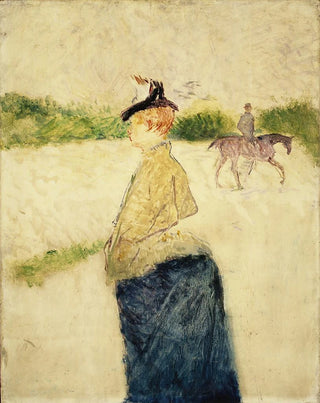Art print | Mille - Henri de Toulouse-Lautrec


View from behind

Frame (optional)
Reproduction Mille - Henri de Toulouse-Lautrec – Captivating Introduction
In the vibrant world of art, some works transcend their era and stand as true witnesses to the society that gave them life. "Mille" by Henri de Toulouse-Lautrec is one of these iconic creations that capture not only the aesthetic of La Belle Époque but also the very essence of Parisian life at the end of the 19th century. This piece, imbued with unparalleled lightness and liveliness, immerses us in the pleasures and excesses of a time when cabaret and celebration reigned supreme. The art print of "Mille" allows us to bring this fascinating universe into our interiors, offering a window into bohemian Paris, where art and life blend in a frenetic dance.
Style and uniqueness of the work
Toulouse-Lautrec's style is immediately recognizable, characterized by bold lines and vibrant colors that infuse his compositions with palpable energy. In "Mille," the artist deploys a rich, shimmering palette, emphasizing contrasts between light and shadow, while playing with shapes and silhouettes. This painting, depicting a cabaret scene, captures the animation and excitement of a moment frozen in time. The figures, both stylized and expressive, seem to come alive under the viewer's gaze, evoking an atmosphere of celebration and conviviality. Through his unique approach, Toulouse-Lautrec manages to create a work that does not merely depict reality but interprets it with sensitivity and modernity that continue to fascinate today.
The artist and his influence
Henri de Toulouse-Lautrec, an emblematic figure of post-impressionism, established himself as one of the most influential artists of his time. Coming from an aristocratic family, he quickly diverged from conventions to embrace the lives of artists and bohemians of Montmartre. His work, marked by a deep empathy for his subjects, bears witness to a unique understanding of humanity and its flaws. Toulouse-Lautrec was able to immortalize iconic figures of his era,

Matte finish

View from behind

Frame (optional)
Reproduction Mille - Henri de Toulouse-Lautrec – Captivating Introduction
In the vibrant world of art, some works transcend their era and stand as true witnesses to the society that gave them life. "Mille" by Henri de Toulouse-Lautrec is one of these iconic creations that capture not only the aesthetic of La Belle Époque but also the very essence of Parisian life at the end of the 19th century. This piece, imbued with unparalleled lightness and liveliness, immerses us in the pleasures and excesses of a time when cabaret and celebration reigned supreme. The art print of "Mille" allows us to bring this fascinating universe into our interiors, offering a window into bohemian Paris, where art and life blend in a frenetic dance.
Style and uniqueness of the work
Toulouse-Lautrec's style is immediately recognizable, characterized by bold lines and vibrant colors that infuse his compositions with palpable energy. In "Mille," the artist deploys a rich, shimmering palette, emphasizing contrasts between light and shadow, while playing with shapes and silhouettes. This painting, depicting a cabaret scene, captures the animation and excitement of a moment frozen in time. The figures, both stylized and expressive, seem to come alive under the viewer's gaze, evoking an atmosphere of celebration and conviviality. Through his unique approach, Toulouse-Lautrec manages to create a work that does not merely depict reality but interprets it with sensitivity and modernity that continue to fascinate today.
The artist and his influence
Henri de Toulouse-Lautrec, an emblematic figure of post-impressionism, established himself as one of the most influential artists of his time. Coming from an aristocratic family, he quickly diverged from conventions to embrace the lives of artists and bohemians of Montmartre. His work, marked by a deep empathy for his subjects, bears witness to a unique understanding of humanity and its flaws. Toulouse-Lautrec was able to immortalize iconic figures of his era,






